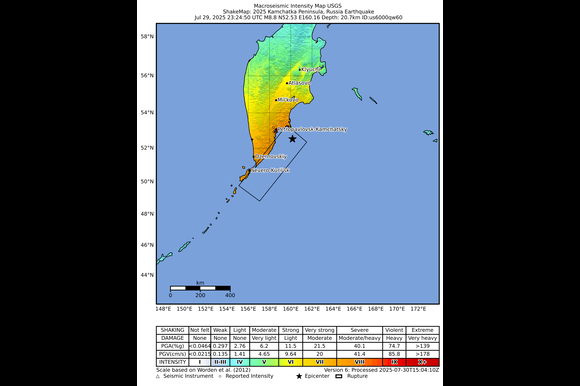Tsunami alerts have been lifted across much of the Pacific following one of the most powerful earthquakes ever recorded, which struck Russia’s Far East early Wednesday.
The magnitude 8.8 earthquake hit near the Kamchatka Peninsula at 11:25 am local time (00:25 BST), triggering widespread tsunami warnings and forcing the evacuation of more than two million people in regions including Russia, Japan, and the U.S. state of Hawaii.
Despite the extraordinary strength of the quake, authorities have reported no major injuries or severe structural damage in any of the affected areas.
“The disaster we feared did not happen,” said Hawaii Governor Josh Green. In Hawaii, waves as high as 1.2 meters reached Oahu, while even larger surges of 1.7 meters were reported on Maui. Thousands along Hawaii’s coastlines moved to higher ground following warnings.
Governor Green had issued a stark warning before the tsunami struck: “It is not a regular wave. It will actually kill you if you get hit by a tsunami.” However, just hours later, he confirmed: “So far we have not seen a wave of consequence.”
The Pacific Tsunami Warning Center (PTWC) downgraded the tsunami warning for Hawaii to an advisory, meaning hazardous conditions such as strong waves, currents, and minor flooding were still possible, but the threat of a major tsunami had passed.
Stephen Logan, director of Hawaii’s Emergency Management Agency, announced that evacuees were permitted to return home but urged them to proceed with caution, drive slowly, and be alert for flooding. On the U.S. West Coast, waves of up to 1.09 meters (3.6 feet) were recorded at Crescent City, California, according to the National Tsunami Warning Center. In San Francisco, tidal surges reached up to 0.7 meters, while in Los Angeles, the weather service warned of a “rapid and damaging surge” at Port San Luis.
In Canada, British Columbia issued a tsunami advisory for most coastal regions, urging residents to avoid the ocean and wait for the all-clear, which was later given as the threat diminished.
Back in Russia, where the quake originated, tsunami waves reaching up to 5 meters (16 feet) hit several areas, including Severo-Kurilsk, a port town of around 2,000 residents who were quickly evacuated. Officials later lifted the tsunami alert for Kamchatka.
In a related development, the powerful earthquake appears to have triggered volcanic activity in the region. The Klyuchevskoy Volcano, Russia’s tallest and most active, began erupting shortly after the quake, with the Geophysical Survey reporting red-hot lava flowing down its western slope.
The Sakhalin region declared a state of emergency in the northern Kuril Islands. Damage to the local power grid prompted authorities to shut it down as a precaution.
Kamchatka Governor Vladimir Solodov described the event as the most powerful earthquake the area has experienced in decades. At least six aftershocks followed, including one with a magnitude of 6.9.
In Japan, tsunami sirens woke thousands during the night. Waves over one meter high hit parts of the Pacific coastline, particularly in Iwate prefecture, where almost two million people were ordered to evacuate. Authorities later downgraded tsunami warnings to advisories for large sections of the country’s coastline, extending from areas north of Tokyo down to Wakayama in the southwest.
Prime Minister Shigeru Ishiba confirmed that, at present, no damage had been reported. At the Fukushima nuclear power plant, all 4,000 workers were evacuated as a safety measure, although the operator stated that no abnormalities had been detected.
Fukushima remains a site of deep national trauma following the 2011 earthquake and tsunami, which caused a nuclear disaster after a 9.0-magnitude quake struck offshore.
Elsewhere in the Pacific, warnings were issued across French Polynesia. Officials raised wave height predictions for Nuku Hiva in the Marquesas Islands to 4 meters, although the French High Commission later reported actual waves peaked at 1.5 meters.
Tsunami warnings were also triggered across several island nations in the Pacific, including Papua New Guinea, the Solomon Islands, and Vanuatu. Residents in coastal regions were urged to evacuate to higher ground as a precaution.
China issued an alert for Zhejiang Province and Shanghai but later cancelled it, reporting no damage. The Philippines and Taiwan also withdrew their warnings. In South America, Peru issued a tsunami alert and closed 65 out of its 125 Pacific ports. Roads near a beach in Lima were also closed. Chile, Costa Rica, Ecuador, Australia, Colombia, Mexico, New Zealand, and Tonga were also placed on alert for possible tsunami activity, with predicted wave heights ranging from 1 to 3 meters.
The earthquake struck a region known for high seismic activity—the Pacific Ring of Fire, where roughly 80% of the world’s earthquakes occur, according to the British Geological Survey. The Ring of Fire is a horseshoe-shaped zone that runs around the edges of the Pacific Ocean and is marked by frequent earthquakes and volcanic eruptions.
Kamchatka, Japan, the Philippines, and much of the Pacific coastline of the Americas lie along this volatile tectonic boundary. Wednesday’s earthquake is now tied as the sixth most powerful earthquake ever recorded, sharing that rank with earlier quakes off the coasts of Chile and Ecuador. The fifth strongest, a 9.0-magnitude quake, also struck near Kamchatka in 1952, generating a devastating 12-meter tsunami.
Though no catastrophic destruction occurred, the scope of global evacuations and alerts reflects the massive scale and danger of the seismic event—a stark reminder of the ever-present threat along the Pacific Rim.






